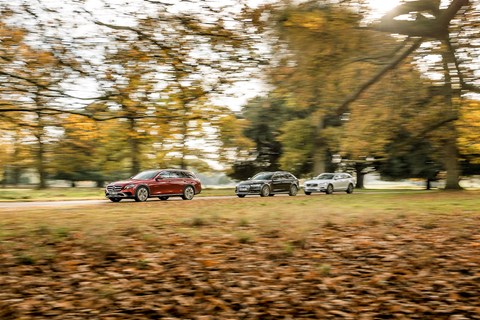► Off-road estates test
► Merc vs Audi vs Volvo
► For the SUV haters
Deep in the heart of Alan Partridge country, it looks like the City has been given a couple of weekdays off as we swish through the lanes, throwing up a gloopy miasma of mud.
The locals around the North Norfolk coast barely give these three big estates a second glance, accustomed as they are to expensive vehicles invading on a regular basis, their inhabitants carefully trimmed in Barbour and Joules, car boots stuffed with hummus, stonebaked breads and stand-up paddleboards.
You can’t help but wonder that the locals might view the Mercedes-Benz E-Class All-Terrain, Volvo V90 Cross Country and Audi A6 Allroad as they might view the weekenders: togged out in mock rural or rough-and-ready technical gear to give the right impression in the beach car park. But crucial to the point of these vehicles is their ability to do more than a passable impression of a proper 4×4, and the Mercedes at first appears to have the widest range of kit to pull off the trick.
It sits 29 millimetres higher than the townie E-Class Estate, half of which is due to the tyres’ taller height/width ratio and half to some more puff in the standard air suspension. Furthermore, in its off-road mode the All-Terrain can hitch up its britches 20mm to provide ground clearance of as much as 156mm.
The Volvo steadies itself at a consistent six centimetres above a standard V90, and likewise for the A6 Allroad, although with its air suspension it can hunker down at higher speeds, as can the All-Terrain. It is noticeable on faster roads too: the Audi and Merc appear to be normal estates, while the Volvo’s taller setting makes it look like Bambi on ice.
Best electric SUVs: how to go rugged electrically
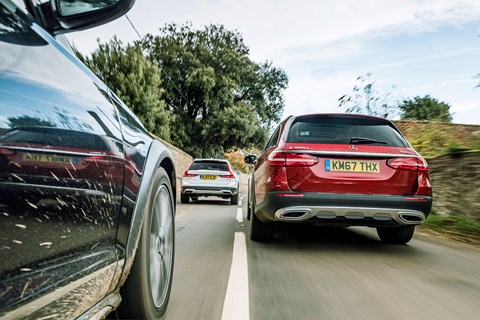
There’s a theme as recurrent as the tide in this test: the Volvo is giving quite a lot away to the other two, but on the flipside it is considerably cheaper. This D5 PowerPulse AWD Cross Country Pro (presumably there will be an Am version for gentleman greenlaners) costs a set of Hunter wellies under £48,000, which is still a whopping amount for a Volvo estate but is positively Black Friday pricing compared to the A6 3.0 BiTDI quattro at almost £58,000 and the E350d 4matic, a further £800 more.
Interestingly the test cars all felt about the same spec, and actually all topped out with extras at more than 60 grand. Of the three, the Mercedes has by far the most standard kit. I’m not sure you can call it good value, but if you’ve got a pile of cash sitting about and want an easy life, you’ll get a lot of car without having to tick any more boxes.
Inside the high-rollers
You can see where Mercedes has spent the money, because the cabin of the All-Terrain uses material of the highest quality, although cream leather and braided chrome slabs with strip LED lighting glowing from every nook and cranny does give it the ambience of a footballer’s dining room rather than an environment for wearing muddy wellies in. It’s a situation which of course can be rectified with the judicious choice of wood and some darker leather, but even so, an E-Class cabin will always be glamorous. Which is fine if looking the part once a month at the yacht club is your thing, less so if you’ve got a pig on the way to slaughter in the boot. I’ll assume the market for this car is the former.
The front seats, though, are utterly marvellous, exquisitely contoured to fit round their occupants like spacesuits. If there are better seats outside of the super-luxury sector, my buttocks have yet to discover them.

The large screen which dominates the dash like a cliff face tends to divide opinion. It can display a bewildering amount of information and hi-res imagery: when you switch into All-Terrain mode you’re treated to the sight of your E sweeping through a dust cloud, for example. But it is a little chintzy. When you get in the Audi and the Volvo, the cabins have none of the glitz or glamour. Whatever floats your yacht, I suppose.
In fact, after the self-indulgence and grandiosity of the All-Terrain, the Allroad feels positively Spartan, and it’s not often you can say that of an Audi. But the A6 is showing its age. I’d been stood out in one of those biting North Sea winds that take a run up from those places where the sun doesn’t shine, got in the A6 and switched it on, then rubbed my gale-stung eyes because everything was fuzzy. Turns out that’s the A6’s screen resolution.
Such is the pace of change that the A6’s controls are looking a bit SD to the other two cars’ HD, with blurry edges and clunkier graphics. It all works with a precise logic, but it lacks the clarity of the Volvo or the fun (a smattering is allowed!) Mercedes has clearly had with the E-Class imagery.
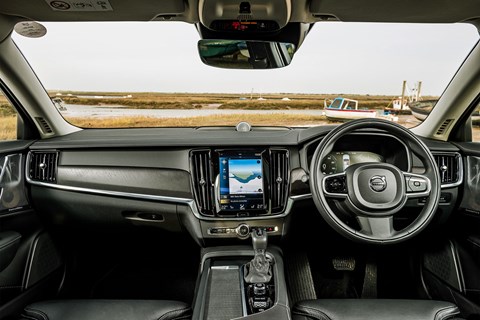
The Cross Country’s cabin, as we have come to expect from the latest generation of Volvos, is more a balance of the two, offering many of the digital functions the Mercedes has, with the stern rationality of the Audi. It’s been said more than once that its iPad-like screen isn’t the fastest and it can be difficult to find stuff, but perhaps I’m a bit slow too because it seems perfectly quick enough for me. Once you’ve had a poke about it’s easy to find all of the things you might need. I’m still unconvinced that touchscreens are safer than buttons in terms of the amount of time spent looking away from the road, though.
Heading rearward, there is only one winner when it comes to space. The E-Class has a vast amount of room in the back and boot, thanks to Mercedes’ curmudgeonly intransigence in refusing to put a new-fangled ‘fast back’ on their E. It is vastly bigger than the other two.
The V90 is a unique and recognisable shape and I love the concave surfaces, but chopping nearly a quarter of the boot space off to get a sharply angled sporty rear feels like Volvo selling out and trying to be something it’s not. I can accept it from Audi – it’s always put form over function – but for those of you making your weekend escape with dogs and sprogs, every litre of space counts, and the All-Terrain is the easy winner with 640 litres, around 80 litres (a whole Labrador!) more than the other two.
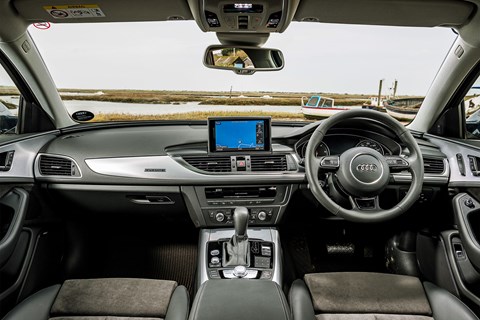
Talking of carrying capacity, both the Audi and the Volvo can tow 2500kg braked, but the Mercedes only lugs 2100kg from its little standard towbar that electrically fluffs itself erect from beneath the rear bumper. But the mere fact that it has a tow bar as standard demonstrates the practicality of the Mercedes All-Terrain, an impression reinforced when you’re manoeuvring around a harbourside full of large metal objects and stone pillars. The E-Class’s reversing camera appears from behind a flap when you engage reverse, which means you can see the looming anchor in pin sharp brightness. Do the same in the Audi and Volvo and people and objects will be lost behind a muddy film, only looming at the last moment out of a gloomy brown seaside soup like an Antony Gormley statue.
Checking out the cladding
I’m not sure about this Hyacinth Red colour of the Mercedes, not least because it could clash with one’s weekend corduroys, but at least it’s a change from the usual drab palette Volvo and Audi offer. Other than this dreadful white, which makes the V90 look like a caravan, there’s not a colour in either range which is brighter and more cheery than North Sea Wash Brown. The All-Terrain can be painted in something a bit purpleish or another greeny-blue one like the bottom of a tropical fish tank. Shame then that probably every buyer will opt for grey, silver or black. Perhaps Audi and Volvo are on to something, after all.
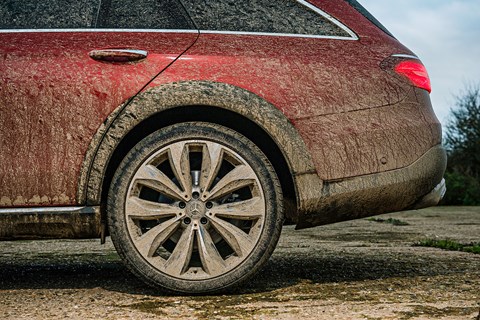
The Audi Allroad’s styling is similarly discreet. Other than a chrome mouth organ on the front skirting, a blade of chrome at the rear and a smear of plastic around the wheelarches, there’s not much to tell anyone this is a puffed-up version of the A6 Avant. Which might be the way Allroad buyers like it, having chosen to avoid bombastic showing-off in an SUV.
The V90 carries a lot more cladding around its nether regions than the other two, which either makes the Cross Country look more utilitarian and eminently sensible, or just cheaper, depending on your point of view. Personally, I like the idea of not wincing every time I scrape past a thorn bush or laneside rock, but then I don’t have the money to own a five-bedroom Farrow and Ball-smeared bolthole with a sea view.
If you do, the E-Class looks the part. It has a big, macho barred grille nicked from a Unimog dressed for a disco, thickly spoked alloys and requisite plastic cladding around the wheelarches. But it’s not all show. Crouch down and the nose of the E is pert, offering more ramp angle than the other two (the Audi would baulk at a pavement kerb), while on the underside it is heavily protected by chunky skid plates.
Are they tough enough?
All of course have permanent four-wheel drive, which we tested as the North Sea drained away towards Europe to reveal short stay car parking for those with good timekeeping and no fear of sticky, gloopy mud. Traction for all three cars is impressively dependable, all dealing with the sorts of surfaces that could embarrass a heavier SUV on big, wide tyres.
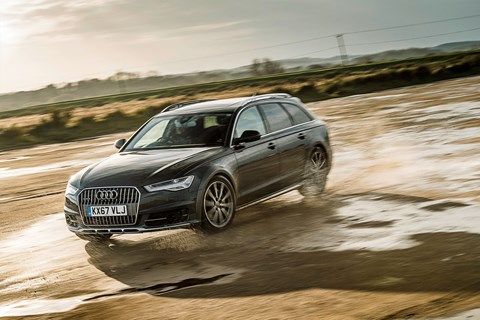
Should on-road handling be your principal concern, I would suggest you don’t buy the Volvo Cross Country. Gone are the days when Volvos had the agility of a barge on the nearby Broads, but dynamically the V90 is still left behind by the other two, and that’s not saying a lot. As standard, it has passive dampers all round, with steel springs at the front and air springs at the rear, but ours came with adaptive dampers all round and yet still gave the impression of a car spread out over a lot of road, with each wheel dealing with separate conditions. The result is a discomfiting oscillation. Going slower, this isn’t as pronounced, but if you increase speed then the effect is exacerbated.
It’s a tendency of most big Volvos, and is a function of their set-up at the more comfortable end of the spectrum, but it is more marked with the higher body of the Cross Country, and not helped by the rollercoastering road surfaces found on seaside country lanes. The steering also has a disconcertingly wide difference between heavy and light at varying speeds, and has that annoyingly dogged trait of always trying to return to centre.
The Audi is the most sporty, and the stiffest and therefore hardest riding, although the steering has as much life as a Norfolk town centre after dark. But it’s accurate and consistent and the quattro system, with its torque vectoring, does a very impressive job of flattening out bends with little fuss. Even though the Allroad is on the venerable side now at more than five years old, it benefits from being one of the first of the generation of quattro models which banished that nose-heavy understeer. It might not be delightful to drive, but it is brutally effective.
The Mercedes All-Terrain, on the other hand, feels very floaty in Comfort mode, with overly light steering. I found myself switching to Sport, which gives up some of the excellent ride quality, but trades that off for less body roll and heavier steering. I’m no great fan of making steering heavier just for the sake of it, preferring to save energy for the extreme kite surfing I would no doubt undertake should I have a car like this, but it helps to give the All-Terrain a more substantial feel. The result is a car that, while you would not dare to call it involving, is able to travel surprisingly rapidly and accurately on even the tightest roads.
Diesel power
This is helped by a quite magnificent engine. The six-cylinder motor in the All-Terrain doesn’t offer a great deal more power at any especially usable level other than the top end, but the deciding factor is a massive third more torque at below 2000rpm than the Volvo and an extra gear for good measure too. The result is stark: it really leaps forward, throwing meaty haymakers in every short gear, while there is a distant, slightly industrial whispery fizz of engine noise. There was a time when Mercedes diesel engines had as much refinement as a tug boat. With this marvellous motor, the All-Terrain sails along as if pushed by a stiff breeze. If diesels were banned next week, automotive historians will say this was one of the very best of the breed.
The Audi, with its biturbo V6, is quicker than the E-Class, and it does it with a more overt display of power, one less gear, a small extra dollop of torque and a noticeably more meaty V6-ish noise coming from under the bonnet (and the speakers). In truth, they are both pretty fleet for cars with aspirations towards going deep into the countryside, and there isn’t much at all between them thanks to the All-Terrain’s extra gear, which helps it extract a lot from a slightly less powerful engine.
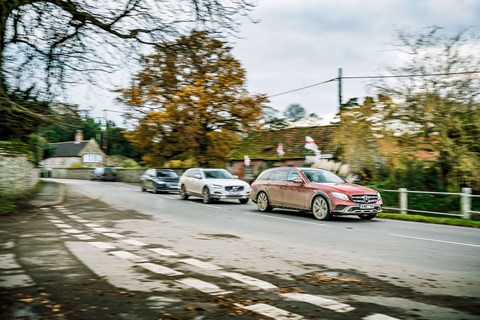
What might not make it into the Museum of Diesel is the four-cylinder Volvo D5. Aptly named PowerPulse, suggesting delivery is intermittent, it certainly feels like a lesser engine compared to the mighty sixes in the other two cars. Thrashy, peaky and pedestrian in comparison, it is a faintly depressing display in a near-£50,000 car. Volvo might have nailed its colours to a future of whizzy electric engines, but in the here and now its four-pot diesel is struggling to hold its own at this level.
The question potential buyers must be asking is this: other than a higher driving position, what can an SUV do that these can’t? All three of them can mudplug with the best of them, all look great, have excellent cabins, handle better and drive more economically than the respective slab-sided cousins in their ranges. But the Mercedes does it all with so much quality, thought and class, and brings plenty of boring old practicality along too. If I had to be heckled as a posh second-home out-of-towner by some aggrieved locals as I drove by, then I would happily, and smugly, be abused in the Mercedes-Benz E-Class All-Terrain.
E-Class All-Terrain vs A6 Allroad vs V90 Cross Country: verdict
First place: Mercedes E350d All-Terrain
A brilliant all-round all-terrain package, if you can tolerate the chintz.
Second place: Audi A6 Allroad
Fast and competent, if a bit long in the tooth.
Third place: Volvo V90 Cross Country
Distinctively Volvo, but with chuggy engine and so-so dynamics
Check out our comparison tests
